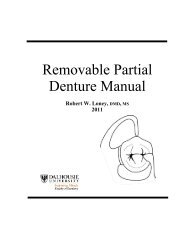Manuals_files/CD Manual 12.pdf - Removable Prosthodontics
Manuals_files/CD Manual 12.pdf - Removable Prosthodontics
Manuals_files/CD Manual 12.pdf - Removable Prosthodontics
You also want an ePaper? Increase the reach of your titles
YUMPU automatically turns print PDFs into web optimized ePapers that Google loves.
Wax Try-in - 63<br />
4. Excursive contacts<br />
If the canine relationship is not acceptable, and will be changed, excursive contacts will<br />
change as well. Nonetheless, the presence of working and balancing contacts should be<br />
evaluated both visually and with articulating paper intraorally, and then compared to the<br />
contacts on the articulator, to verify the accuracy of the articulator settings. If the<br />
contacts appear noticeably different (check the amount of space between posterior teeth<br />
in excursions) or the markings are different between the intraoral and articulator<br />
situations, the protrusive record should be remade, and the condylar inclination reset.<br />
5. Esthetics<br />
Check the amount of the incisal display, the harmony of the maxillary teeth with the<br />
smile line, the accuracy of the midline, and the cant of the occlusal plane. Check for<br />
proper soft tissue profile, contours, lip support, display of the vermilion border, and<br />
correct nasolabial angle. Ask the patient for their opinion of the appearance, prior to<br />
voicing your opinion so that you avoid biasing the patient. It can be helpful to have a<br />
family member or friend attend the wax try-in to provide a third opinion on appearance.<br />
If you or the patient have reservations about the appearance, the problem should be<br />
clearly resolved prior to final processing. Never attempt to persuade a patient out of a<br />
concern they may have – the problem will be yours later if the patient still does not like<br />
the appearance. It is helpful to the technician if the dentist can make changes, but major<br />
changes can be delegated to the lab, if necessary.<br />
6. Phonetics<br />
Phonetics can be assessed more readily at the try-in stage since denture teeth have<br />
replaced the relatively bulky occlusion rims. Patients will normally find speaking more<br />
comfortable at this appointment. Watch for lisping. It can be caused by non-uniform<br />
overjet of the anterior teeth, diastemas between teeth or faulty palatal contours.<br />
Sometimes a crowded tongue space can adversely affect phonetics. If the initial wax tryin<br />
has a diastema between anterior and posterior teeth due to canine malrelationship, this<br />
can allow for the escape of air, and produce altered phonetics. In most instances<br />
phonetics can not be corrected until the final wax tryin, when the diastemas should be<br />
eliminated. If patients have not worn dentures for an extended period, or if the new<br />
denture will have dramatic changes in contour, tooth position and/or vertical dimension,<br />
the patient should be allowed to read a passage from a magazine out loud for 5 minutes to<br />
allow them time to assess phonetics and comfort.















